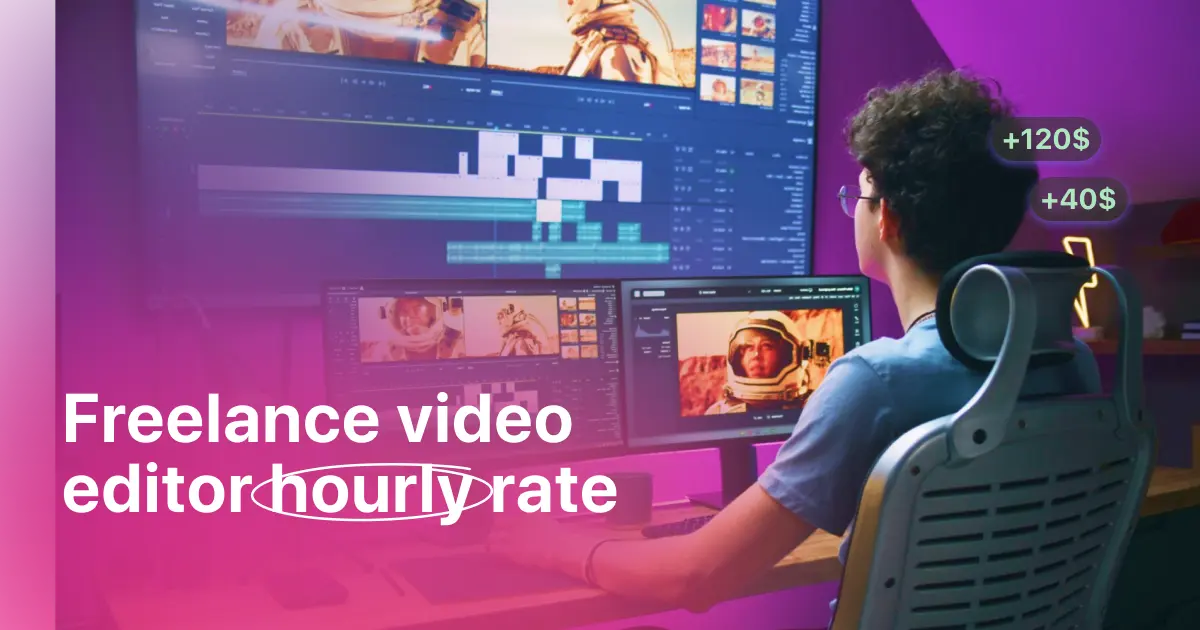Plans built for businesses
Pro + AI
For pro video creation
Advanced + AI
For users who want to generate video ads
*Billed yearly
Compare plans
Freelance Video Editor Rates Overview (Factors, Types, Models)
20 June, 2024
Becoming a freelance video editor offers the flexibility to work on diverse projects and the opportunity to earn a lucrative income. However, one of the most critical aspects of freelancing is understanding how to set your rates.
In this article, we will provide a comprehensive overview of freelance video editor rates, including the types of projects, factors influencing rates, and common pricing models. Whether you are a seasoned professional or just starting, this guide will help you navigate the complexities of setting your hourly rate and determining the best pricing strategy for your services.
The Main Types of Freelance Video Editing Projects
Freelance video editors can work on a variety of projects, each with its unique requirements and pricing structures. Here are the main types of projects you might encounter:
Corporate Videos
Corporate videos are created for businesses to promote their brand, products, or services. These projects often include company overviews, training videos, and promotional content. The complexity and length of the video can significantly impact the freelance video editor's hourly rate.
On average, rates for corporate video editing can range from $25 to $75 per hour, depending on the project's scope and the editor's experience.
Social Media Content

With the rise of platforms like Instagram, TikTok, and YouTube, there is a high demand for short, engaging videos tailored for social media. These projects typically require quick turnaround times and a strong understanding of platform-specific trends.
Freelance video editor rates for social media content can vary widely, generally falling between $20 and $50 per hour. Editors with expertise in creating viral content or with a strong portfolio can command higher rates.
Film and TV Post-Production
Editing for film and TV is a specialized field that often requires extensive experience and advanced technical skills. These projects can range from editing short films to working on full-length features or TV episodes.
Due to the high level of expertise required, the hourly rate for freelance video editors in this niche can be quite high, often ranging from $50 to $150 per hour.
Event Videography

Event videography involves editing footage from live events such as weddings, conferences, and concerts. These projects often require a mix of creative storytelling and technical skills to create compelling narratives from raw footage.
Rates for event videography editing can range from $30 to $60 per hour, depending on the event's complexity and the editor's experience.
Educational Videos
Educational videos are used for online courses, tutorials, and other instructional content. These projects require clarity and precision to ensure the material is easy to follow and engaging.
Freelance video editor hourly rates for educational videos typically range from $25 to $60 per hour.
5 Factors Influencing Video Editors' Rates
Several factors can influence the rates freelance video editors charge. Understanding these factors can help you set competitive and fair rates while ensuring your services are valued appropriately.
Experience and Expertise
Experience plays a crucial role in determining freelance video editor rates. Editors with several years of experience or specialized skills in certain types of video editing can command higher rates.
Additionally, editors who stay updated with the latest software and techniques are often able to charge more for their services.
Project Complexity
The complexity of the project is another significant factor. Projects that require advanced editing techniques, special effects, or intricate storytelling will generally demand higher rates.
For example, editing a feature film with multiple camera angles and high-end special effects will be priced higher than a simple social media video.
Turnaround Time
Clients often require quick turnarounds, especially for time-sensitive content like event highlights or social media posts.
Offering expedited services can justify higher rates. Freelance video editors commonly charge a premium for rush jobs to compensate for the additional time and effort required.
Client Budget
The client's budget can also influence the hourly rate for freelance video editors. Larger corporations and established brands typically have bigger budgets and are willing to pay more for high-quality work.
On the other hand, smaller businesses or individual clients may have limited budgets, which can affect how much you can charge.
Geographic Location
Geographic location can impact freelance video editor rates due to cost-of-living differences. Editors based in major cities or regions with a higher cost of living often charge more than those in less expensive areas.
However, the rise of remote work has made it possible to work with clients worldwide, potentially balancing out these differences.
Common Video Editing Pricing Models
Freelance video editors can choose from various pricing models, each with its pros and cons. Understanding these models can help you select the best approach for your business and clients.
Hourly Rate
Charging an hourly rate is one of the most straightforward pricing models. This method ensures you are compensated for the actual time spent on a project. Freelance video editor hourly rates can vary widely based on the factors discussed earlier, typically ranging from $20 to $150 per hour.
Pros:
-
Clear and transparent pricing.
-
Flexibility to adjust rates based on project complexity.
Cons:
-
Clients may be hesitant if they are unsure of the total project duration.
-
Potential for disagreements if clients question the number of hours billed.
Flat Fee
A flat fee pricing model involves charging a fixed price for the entire project, regardless of how long it takes to complete. This model is often used for well-defined projects with a clear scope, such as editing a specific type of video or producing a set number of deliverables.
Pros:
-
Predictable costs for clients.
-
Encourages efficiency, as your earnings are not tied to hours worked.
Cons:
-
Risk of underestimating the time required, leading to lower effective hourly rates.
-
Less flexibility for changes in project scope.
Per Minute of Edited Video
Charging per minute of edited video is common for projects like documentaries or educational videos. Rates typically range from $50 to $300 per minute of finished video. The rate depends on the complexity and editing required.
For instance, basic edits might be at the lower end, while more intricate work with animations and effects would be at the higher end.
Day Rate
Day rates for video editors can vary widely based on experience and location. On average, day rates range from $300 to $1,500 per day. Editors in major markets like New York or Los Angeles might command higher rates, typically between $750 and $1,500 per day.
The actual rates can vary based on individual expertise, the project's demands, and market conditions.
Per Minute of Edited Video
Some video editors charge based on the final length of the edited video, often quoted as a rate per minute of edited footage. This model is common for projects like educational videos, corporate videos, and documentaries.
Pros:
-
Simple and easy-to-understand pricing structure.
-
Aligns payment with the length of the final product.
Cons:
-
May not account for the complexity of editing required.
-
Potential for discrepancies if the final video length differs significantly from initial estimates.
Retainer Agreements
Retainer agreements involve clients paying a set fee regularly (e.g., monthly) for ongoing video editing services. This model provides steady income and can help build long-term client relationships.
Pros:
-
Predictable and stable income.
-
Encourages long-term client relationships.
Cons:
-
Requires a commitment to provide a set amount of work regularly.
-
May limit the ability to take on new projects.
Conclusion
Setting your rates as a freelance video editor involves considering various factors, from the types of projects you take on to your experience level and the complexity of the work. By understanding the different types of video editing projects, the factors that influence rates, and the common pricing models, you can make informed decisions that reflect the value of your services.
Whether you choose to charge an hourly rate, a flat fee, or another pricing model, it's essential to communicate clearly with clients and be transparent about your pricing structure. This approach not only builds trust but also ensures you are fairly compensated for your skills and efforts.
As you establish yourself in the freelance video editing market, remember to stay adaptable and continuously update your skills. The industry is constantly evolving, and keeping up with new trends and technologies will help you remain competitive and justify higher rates. With careful consideration and strategic planning, you can achieve a successful and rewarding career as a freelance video editor.










